Study on the Mechanism Effect of Bending Loads on the Decay-like Degradation of Composite Insulator GFRP Core Rod
Abstract
:1. Introduction
2. Microscopic Damage Evolution Simulation of GFRP Materials under Alternating Loads
2.1. Force Analysis of V-String Composite Insulators
2.2. The 3D Model and Material Constitutive Model of GFRP Core Rod Material
2.3. Damage and Deterioration Process of GFRP Core Rod Material under Alternating Loads
3. Multi-Factor Aging Test of Composite Insulators under Wet-Hot and Alternating Loads
3.1. Sample Selection
3.2. Experimental Setup
3.3. Testing and Characterization
3.3.1. Scanning Electron Microscopy Testing
3.3.2. Thermogravimetric Analysis
3.3.3. Fourier Transform Infrared Spectroscopy Analysis
3.3.4. Charged Temperature Rise Experiment
3.3.5. Moisture Absorption Test
3.3.6. Dielectric Loss Factor Test
3.4. Experiment Result
3.4.1. Appearance Inspection
3.4.2. Microscopic Morphology Analysis
3.4.3. Thermogravimetric Analysis Results
3.4.4. Fourier Transform Infrared Spectroscopy Analysis Results
3.4.5. Artificial Aging Test Sample Charged Temperature Rise Test
3.4.6. Analysis of Moisture Absorption and Dielectric Loss Characteristics
4. Analysis and Discussion
5. Conclusions
- (1)
- Compact V-string composite insulators were found to be susceptible to the influence of alternating flexural loads. A detailed examination of the damage evolution in GFRP core rod material revealed that fatigue damage was initiated from the outer surface of the core rod’s bending arc due to alternating flexural loads. It propagated towards the core rod’s interior, beginning with epoxy resin matrix damage on its surface, subsequently leading to fiber breakage.
- (2)
- The establishment of a multi-factor composite insulator artificially aging platform, combining moisture, heat, and mechanical stress, allowed for accelerated aging tests. Microscopic morphology observation and physicochemical analysis indicates that while subjecting the test specimen to 400,000 alternating load cycles, the core rod underwent stages of surface damage, an increase damage, fatigue embrittlement, matrix hydrolysis, and fiber fracture. The deterioration primarily occurred on the outer side of the composite insulator’s bending arc.
- (3)
- Electric temperature rise tests were conducted on composite insulator specimens subjected to different numbers of alternating load cycles. It was observed that the deterioration of composite insulator specimens gradually intensified with an increasing number of alternating load cycles. Both the temperature rise range and the degree increased, with the temperature rise region and maximum temperature rise primarily occurring at the point where the bending deflection of the composite insulator was at its maximum, indicating that this position was the most severely deteriorated part.
- (4)
- Both the dielectric loss factor and saturation moisture absorption rate of the test samples exhibited an initially slow increase, followed by rapid growth and then a gradual increase with an increasing number of alternating load cycles. Test results showed that the dielectric loss factor and saturation moisture absorption rate for slices from the new insulator were 3.45% and 0.04%, respectively. However, after 400,000 alternating load cycles, the deteriorated core rod’s dielectric loss factor and saturation moisture absorption rate significantly increased to 30.68% and 0.6%, respectively, in contrast to the new samples.
- (5)
- As the times of alternating flexural loads increased, the depth of core rod deterioration continuously deepened. The microcracks and pores formed inside the core rod distort the electric field and provided pathways for accelerated moisture ingress. This, in turn, increased dielectric material polarization loss, causing abnormal temperature to rise in the deteriorated section of the composite insulator.
Author Contributions
Funding
Data Availability Statement
Conflicts of Interest
References
- Liang, X.; Gao, Y.; Wang, J.; Li, S. Rapid Development of Silicone Rubber Composite Insulator in China. High Volt. Eng. 2016, 42, 2888–2896. (In Chinese) [Google Scholar]
- Yang, L.; Yu, J.; Guo, Y.; Chen, S.; Tan, K.L.; Li, S. An Electrode-Grounded Droplet-Based Electricity Generator (EG-DEG) for Liquid Motion Monitoring. Adv. Funct. Mater. 2023, 33, 2302147. [Google Scholar] [CrossRef]
- Liu, Z. Present Situation and Prospects of Applying Composite Insulators to UHF Transmission Lines in China. Power Syst. Technol. 2006, 30, 1–7. (In Chinese) [Google Scholar]
- Guan, Z.; Peng, G.; Wang, L. Application and Key Technical Study of Composite Insulators. High Volt. Eng. 2011, 37, 513–519. (In Chinese) [Google Scholar]
- Dai, J. Study of Brittle Fracture of High Voltage Composite Insulators. Master’s Thesis, Tsinghua University, Beijing, China, 2006. (In Chinese). [Google Scholar]
- Liang, X.; Huang, L.; Wang, S. Composite insulator flashovers caused by bird dropping and unknown reasons. Power Syst. Technol. 2001, 25, 13–16. (In Chinese) [Google Scholar]
- Zhang, Y.; Hou, S.; Geng, J.; Gong, Y.; Zhong, Z. Diagnosis Method of Decay-like Composite Insulators in a High-Humidity Environment Based on Characteristic Coefficient of Temperature Rise Gradient. Polymers 2023, 15, 2715. [Google Scholar] [CrossRef] [PubMed]
- Wang, J.; Liang, X.; Gao, Y. Failure analysis of decay-like fracture of composite insulator. IEEE Trans. Dielectr. Electr. Insul. 2014, 21, 2503–2511. [Google Scholar] [CrossRef]
- Gao, Y.; Liang, X. Study on Decay-Like Fracture of Composite Insulator, Part II: Experimental Simulation and Preventive Method Discussion of Decay-Like Fracture. Proc. CSEE 2016, 36, 5070–5077+5132. (In Chinese) [Google Scholar]
- Zeng, L. Study on Abnormal Heating and Hygrothermal Aging Characteristics of Composite Insulators. Master’s Thesis, South China University of Technology, Guangzhou, China, 2019. (In Chinese). [Google Scholar]
- Zhao, Y. Study on the Deterioration Characteristics of the Core of Composite Insulators under Hygrothermal Environment. Master’s Thesis, North China Electric Power University, Beijing, China, 2018. (In Chinese). [Google Scholar]
- Ma, X. Research on the Influence of Moisture Immersion on the Internal Deterioration Process of Composite Insulator. Master’s Thesis, Dalian University of Technology, Dalian, China, 2022. (In Chinese). [Google Scholar]
- Noonan, M.; Obande, W.; Ray, D. Simulated End-of-Life Reuse of Composites from Marine Applications Using Thermal Reshaping of Seawater-Aged, Glass Fibre-Reinforced Acrylic Materials. Compos. Part B Eng. 2024, 270, 111118. [Google Scholar] [CrossRef]
- Stupar, S.; Vuksanović, M.M.; Mijin, D.Ž.; Milanović, B.C.; Joksimović, V.J.; Barudžija, T.S.; Knežević, M.R. Multispectral Electromagnetic Shielding and Mechanical Properties of Carbon Fabrics Reinforced by Silver Deposition. Mater. Chem. Phys. 2022, 289, 126495. [Google Scholar] [CrossRef]
- Stupar, S.; Vuksanović, M.M.; Mijin, D.Ž.; Bučko, M.; Joksimović, V.J.; Barudžija, T.S.; Tanić, M.N. Functional Nano-Silver Decorated Textiles for Wearable Electronics and Electromagnetic Interference Shielding. Mater. Today Commun. 2023, 34, 105312. [Google Scholar] [CrossRef]
- Nicolalde, J.F.; Yaselga, J.; Martínez-Gómez, J. Selection of a Sustainable Structural Beam Material for Rural Housing in Latin América by Multicriteria Decision Methods Means. Appl. Sci. 2022, 12, 1393. [Google Scholar] [CrossRef]
- Chen, Y.; Xue, W.; Liu, Y. Influence of Silicone Rubber Content of Shed and Sheath on Composite Insulator Lifespan. High Volt. Eng. 2022, 48, 736–752. (In Chinese) [Google Scholar]
- Le, B.; Hou, L.; Wang, L.; Zhu, P. Study on loading characteristics of V type composite insulator used in 330 kV compact line. Proc. CSEE 2005, 25, 91–95. (In Chinese) [Google Scholar]
- Diana, G.; Cheli, F.; Manenti, A.; Nicolini, P.; Tavano, F. Oscillation of Bundle Conductors in Overhead Lines due to Turbulent Wind. IEEE Trans. Power Deliv. 1990, 5, 1910–1922. [Google Scholar] [CrossRef]
- Zhu, K.; Liu, B. Calculation of Torsional Stiffness of Bundle Conductors in Overhead Transmission Lines. Power Syst. Technol. 2010, 34, 210–214. (In Chinese) [Google Scholar]
- Zhang, Z.; Pang, G.; Lu, M.; Gao, C.; Jiang, X. Research on Silicone Rubber Sheds of Decay-Like Fractured Composite Insulators Based on Hardness, Hydrophobicity, NMR, and FTIR. Polymers 2022, 14, 3424. [Google Scholar] [CrossRef] [PubMed]
- DL/T 1580-2016; Technical Specification for Core of Long Rod Composite Insulators for a. c. or d. c. Systems. China National Energy Administration: Beijing, China, 2016.
- GB/T 34937-2017; Insulators for Overhead Lines—Composite Suspension and Tension Insulators for d. c. Systems with a Nominal Voltage Greater than 1500 V—Definitions, Test Methods and Acceptance Criteria. China National Standardization Administration: Beijing, China, 2017.
- GB/T 13096-2008; Test Method for Mechanical Properties of Pultruded Glass Fiber Reinforced Plastic Rods. China National Standardization Administration: Beijing, China, 2008.
- Zhang, Z.; Huang, Q.; Geng, J.; Liu, Q.; Zhang, S. Defect Identification of Composite Insulator Based on Infrared Image. Polymers 2022, 14, 2620. [Google Scholar] [CrossRef]
- Gao, S.; Liu, Y.; Li, L. A Comparative Study of Abnormal Heating Composite Insulators. Polymers 2023, 15, 2772. [Google Scholar] [CrossRef]
- ASTM D5229/D5229M-20; Standard Test Method for Moisture Absorption Properties and Equilibrium Conditioning of Polymer Matrix Composite Materials. ASTM International: West Conshohocken, PA, USA, 2020.
- Li, X.; Zhang, Y.; Chen, L.; Fu, X.; Geng, J.; Liu, Y.; Gong, Y.; Zhang, S. Study on the Ageing Characteristics of Silicone Rubber for Composite Insulators under Multi-Factor Coupling Effects. Coatings 2023, 13, 1668. [Google Scholar] [CrossRef]
- Wang, Q.; Bao, W.; Gao, Y.; Liu, S.; Liu, S.; Zuo, Z.; Wu, C.; Liang, X. Influence of Surface Discharge on Resin Degradation in Decay-like Fracture of Composite Insulators. Polymers 2023, 15, 790. [Google Scholar] [CrossRef] [PubMed]
- Yuan, Z.; Wang, C.; Jin, L.; Tu, Y.; Zhang, Y.; An, Z.; Zhao, Y. A Modified Langmuir Model for Moisture Diffusion in UGFRE of Composite Insulator Considering the Composite Degradation. Polymers 2022, 14, 2922. [Google Scholar] [CrossRef] [PubMed]
- Zhong, Z.; Chen, Y.; Liu, Y.; Hou, S.; Geng, J. Study on the influence mechanism of ambient humidity on the temperature rise of decay-like composite insulators. High Volt. 2022, 7, 916–924. [Google Scholar] [CrossRef]
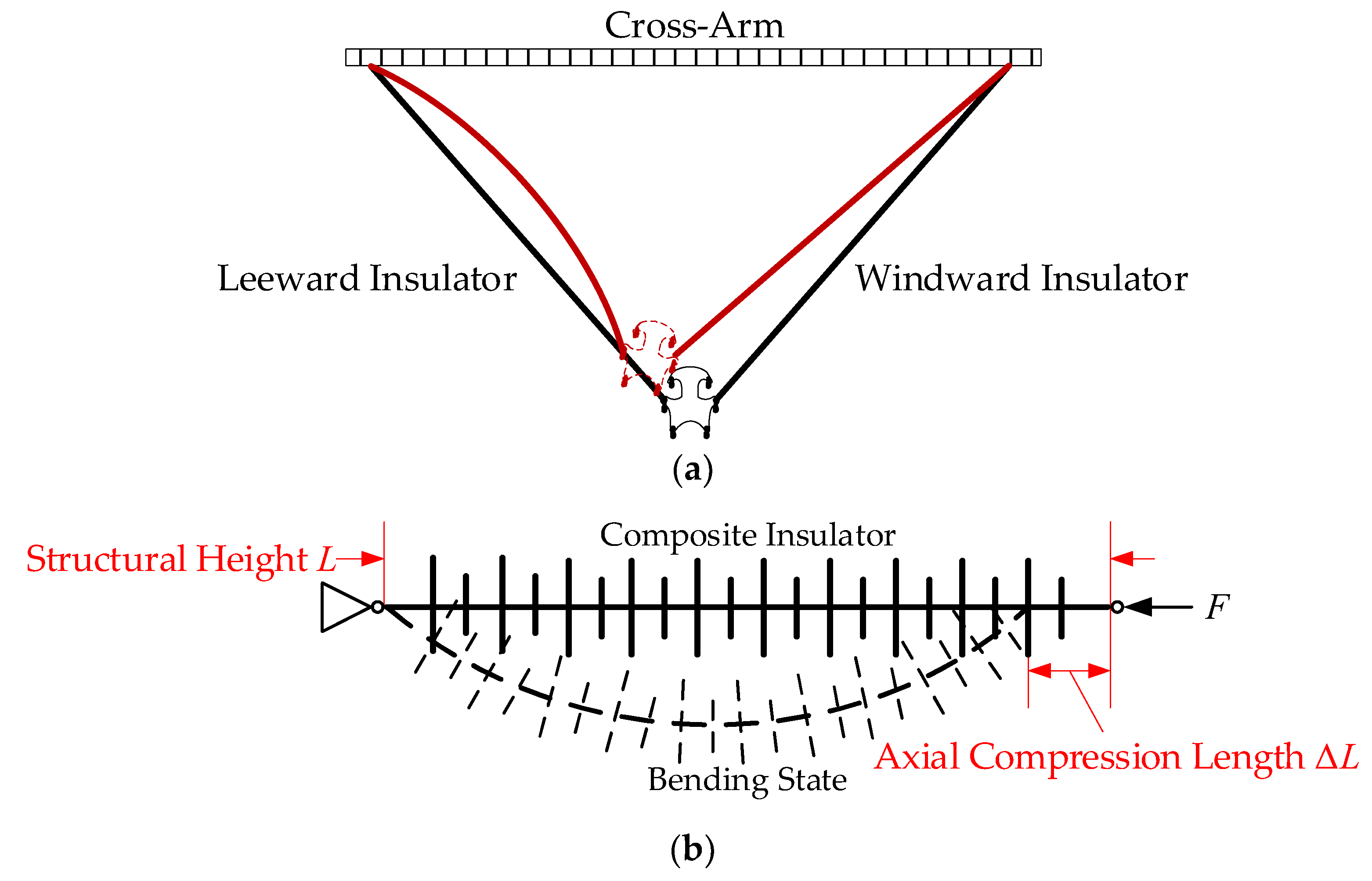
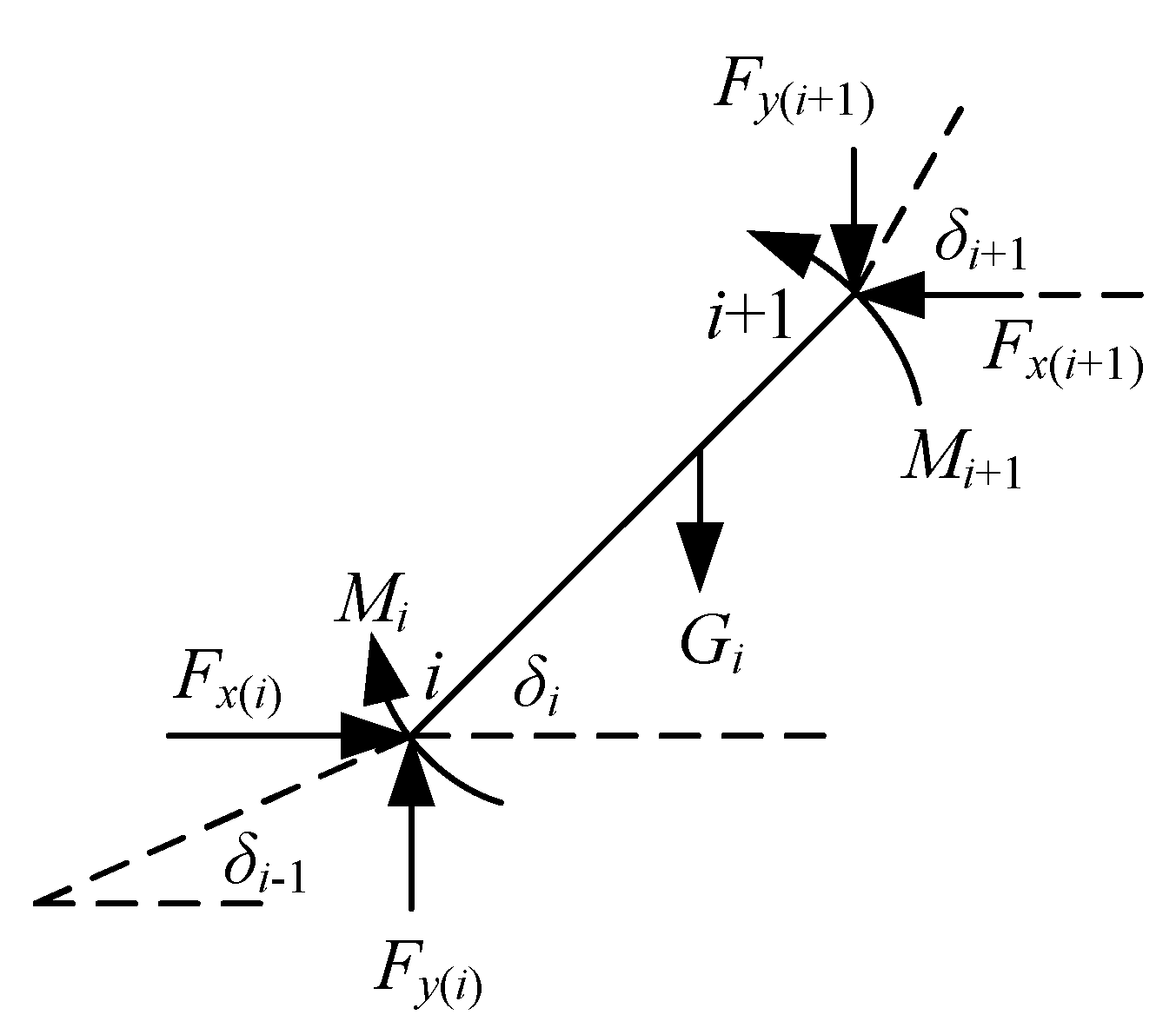
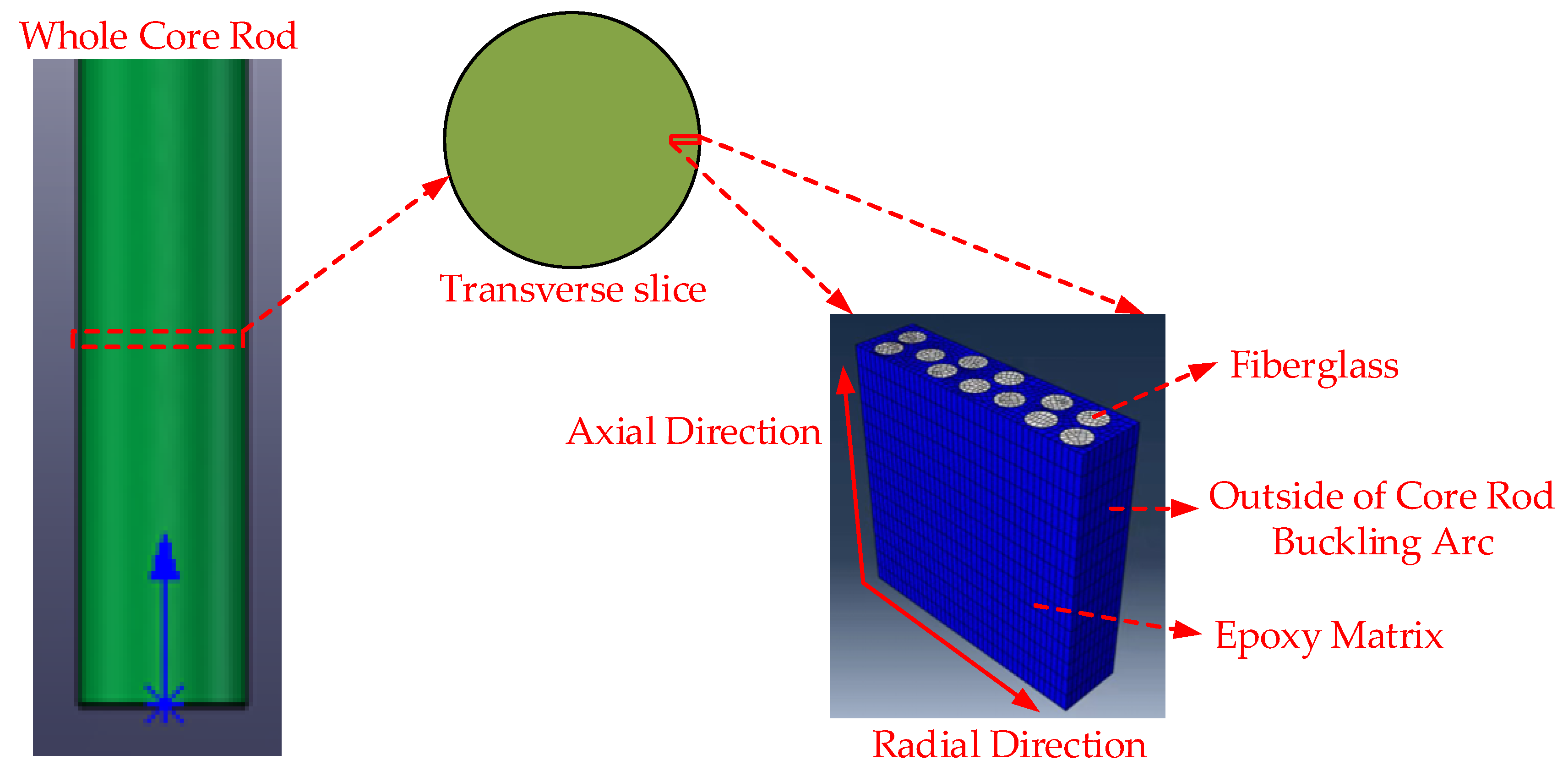


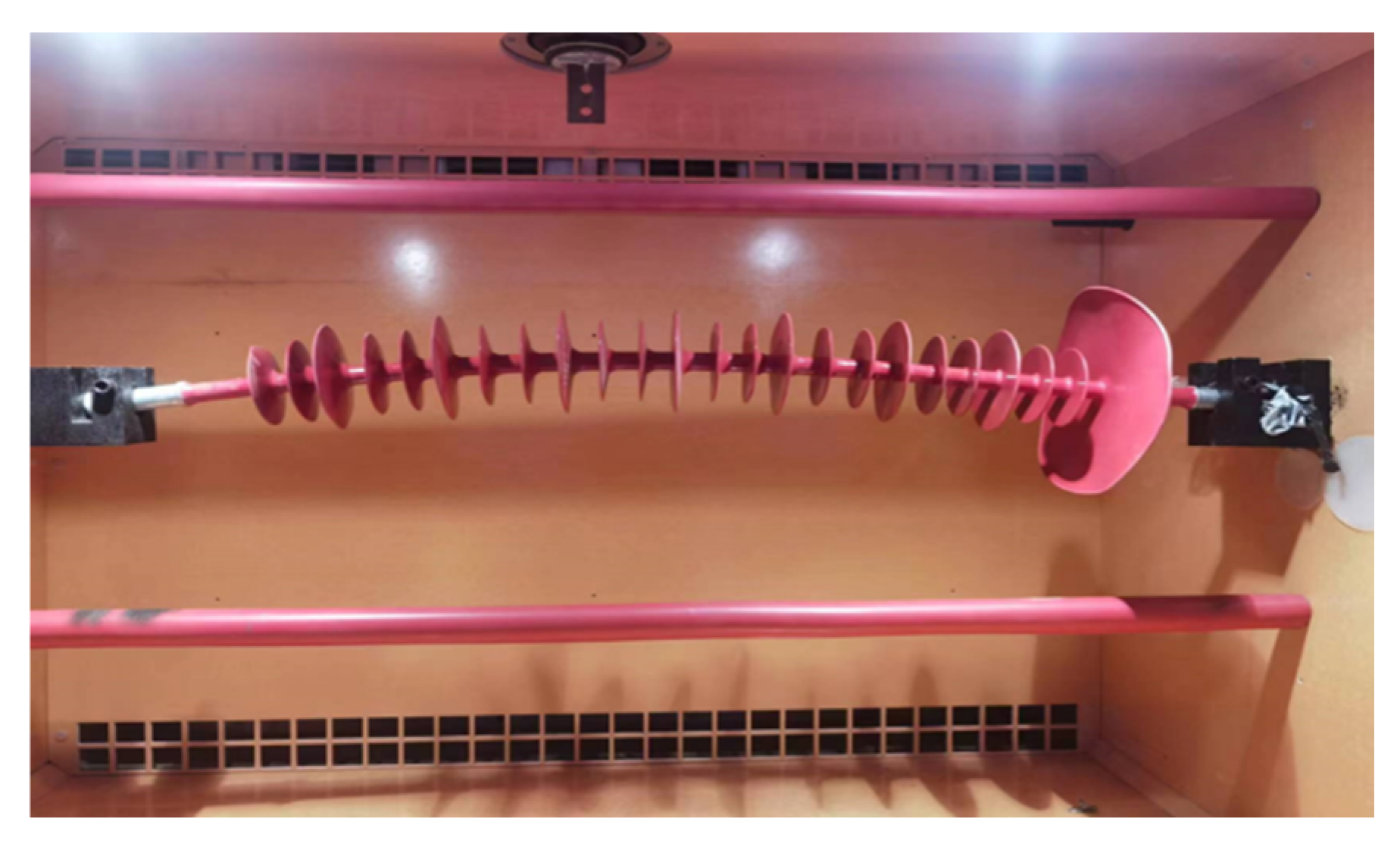

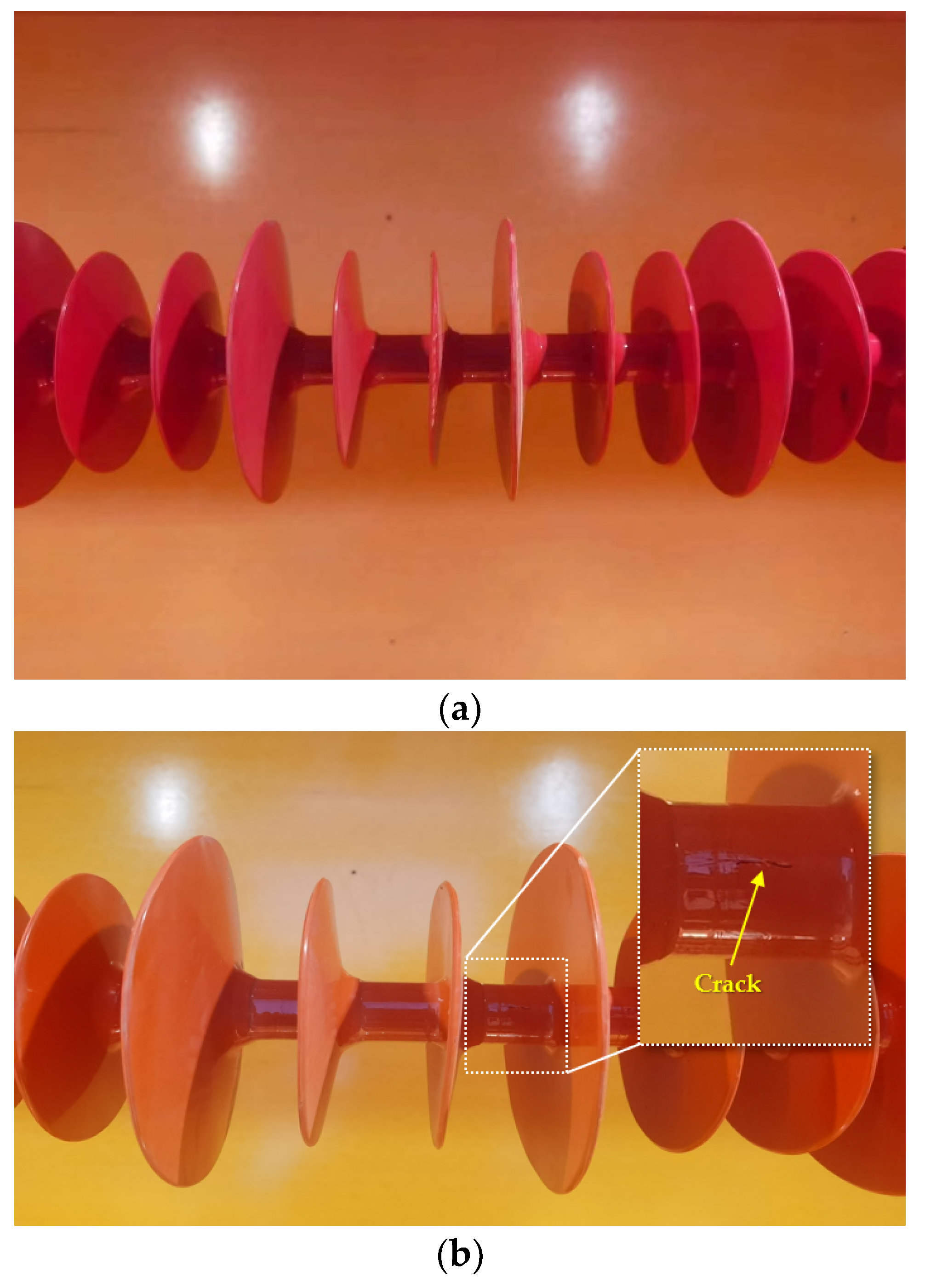

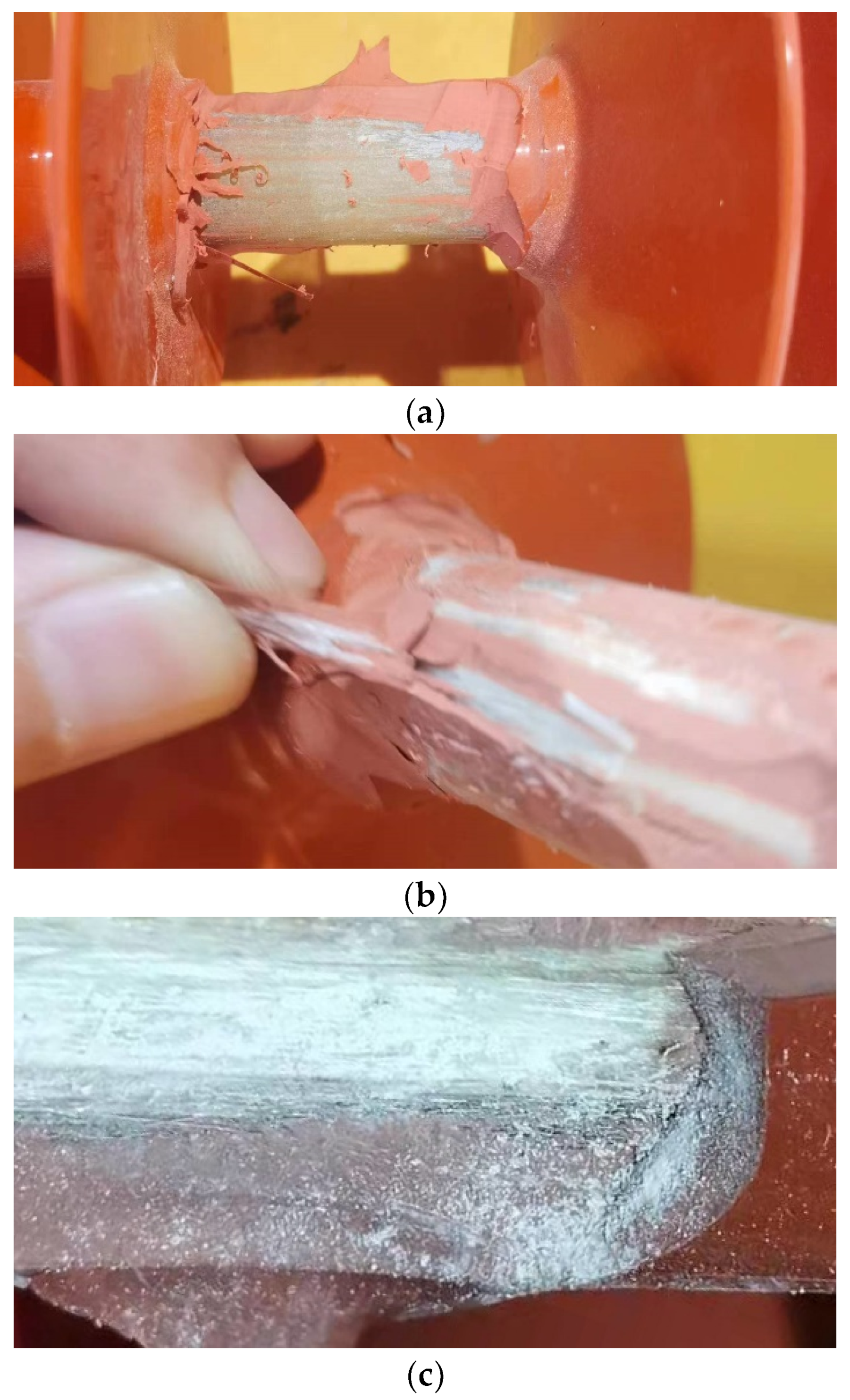
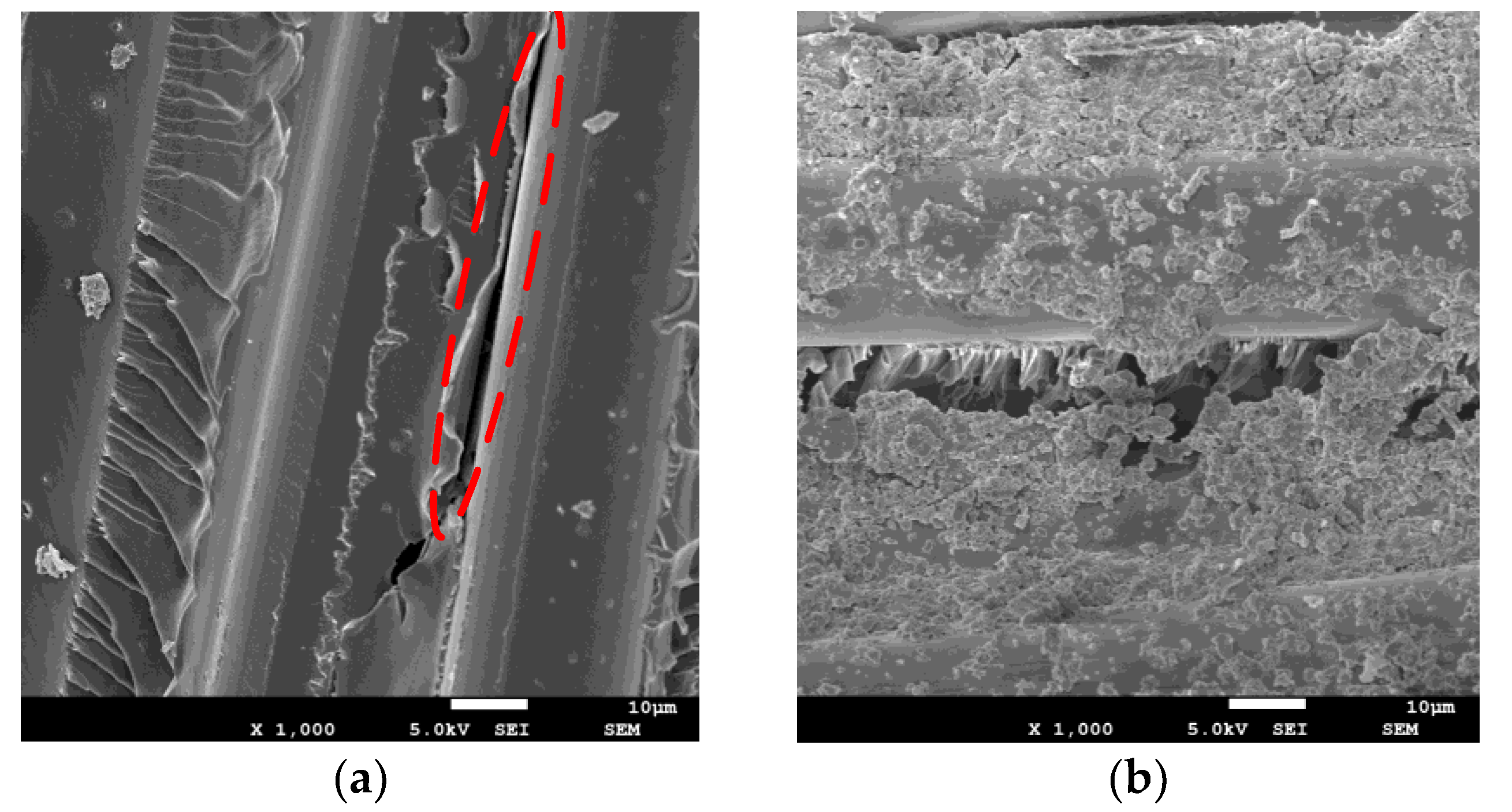
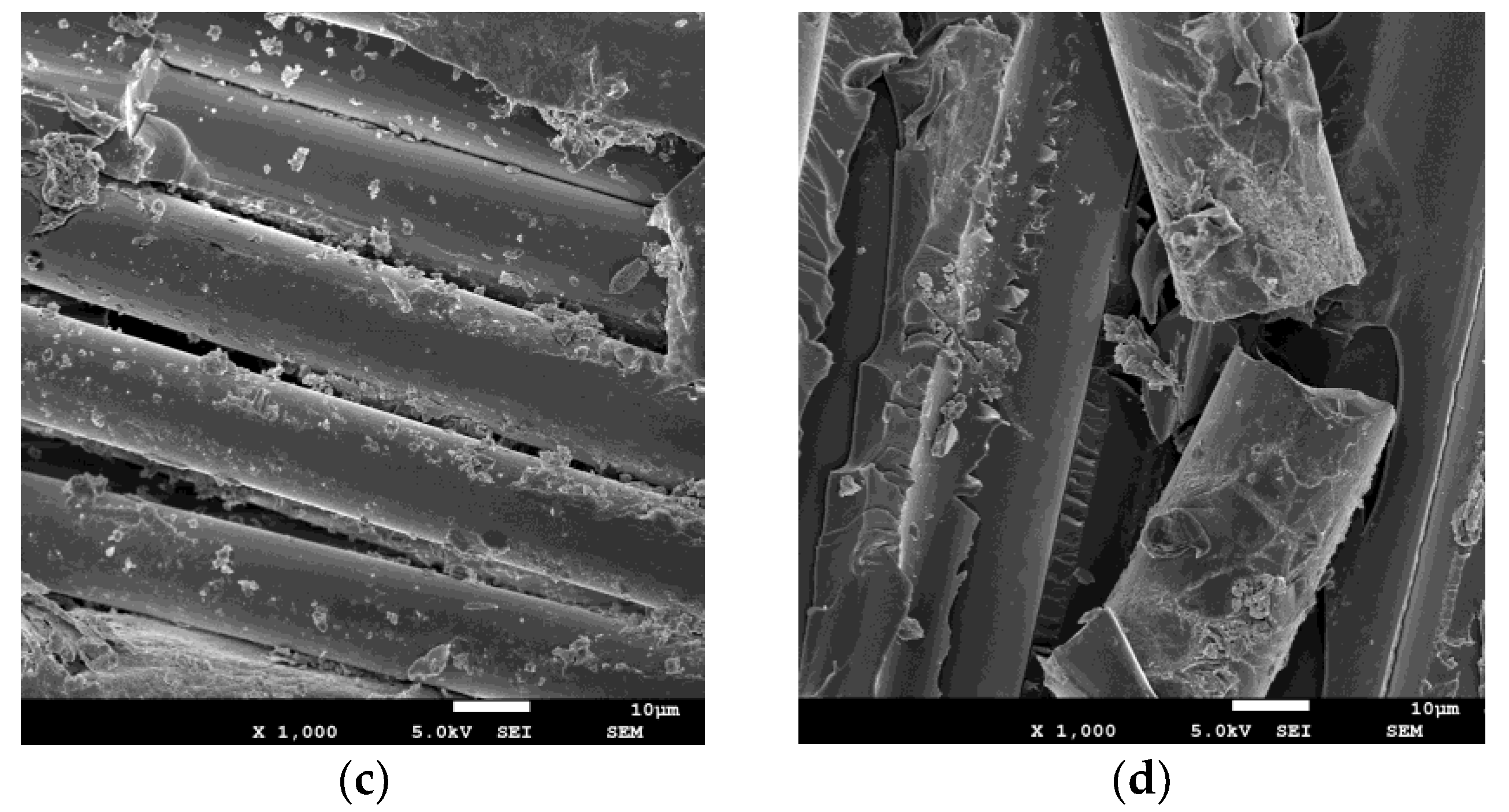
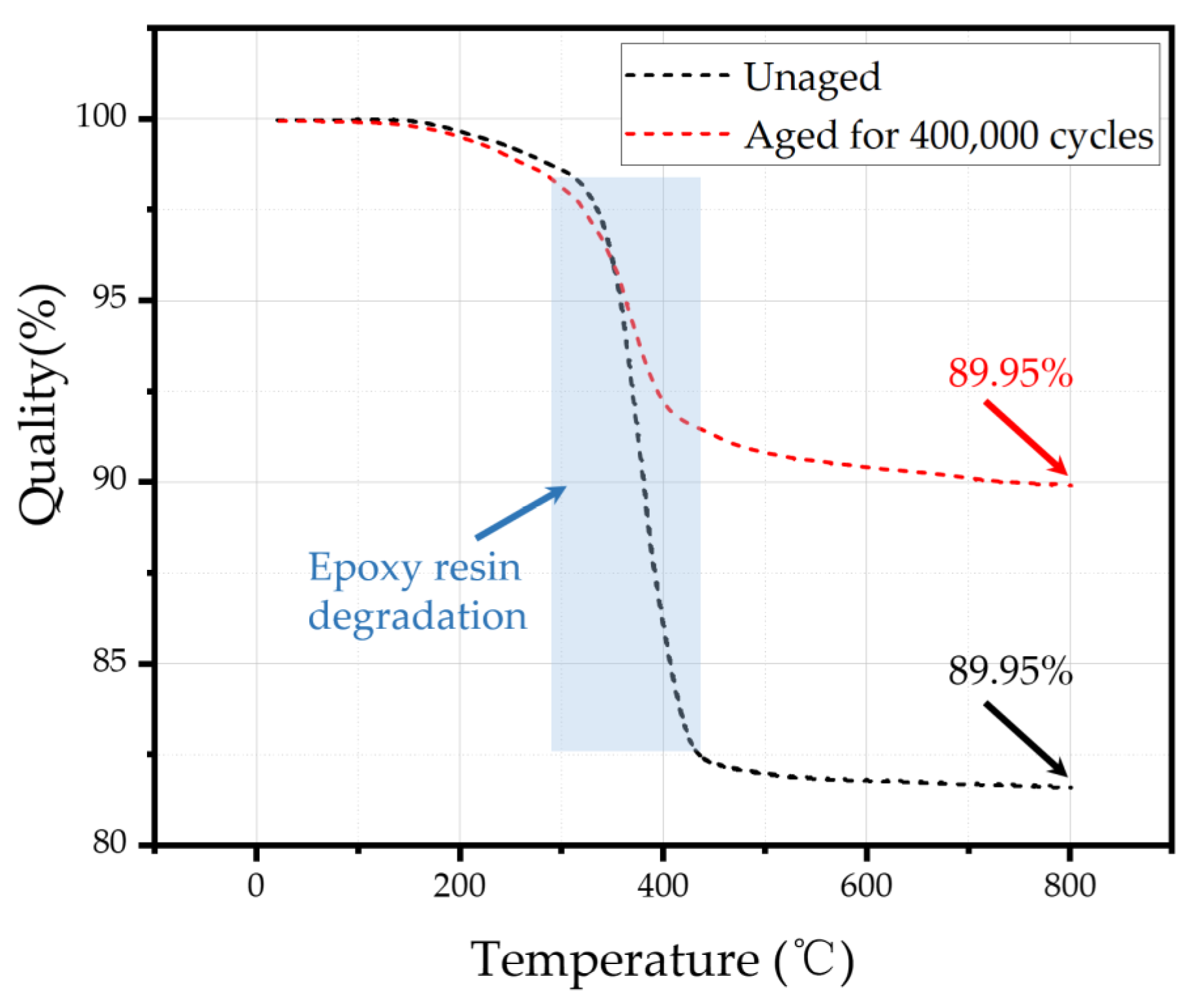
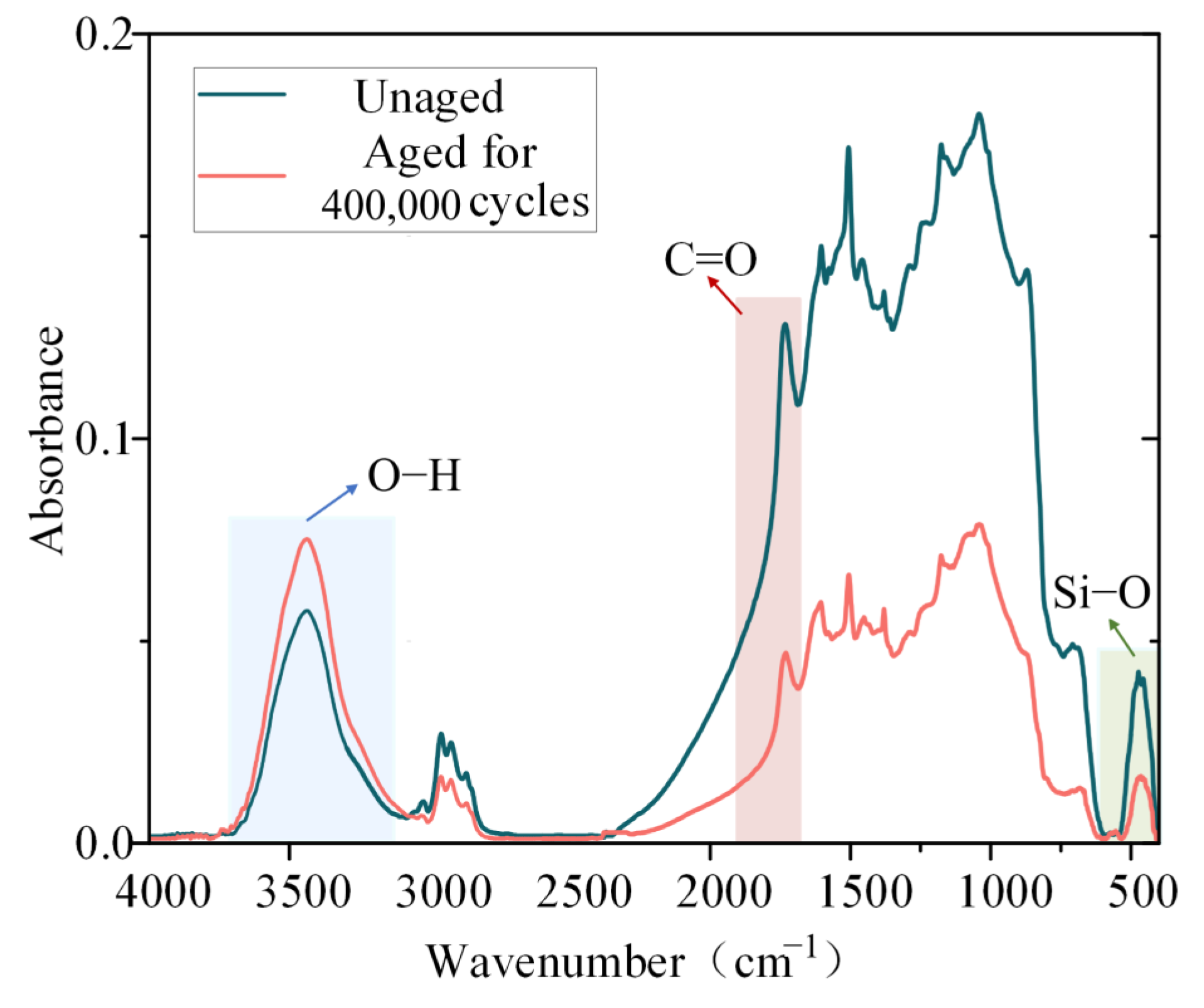
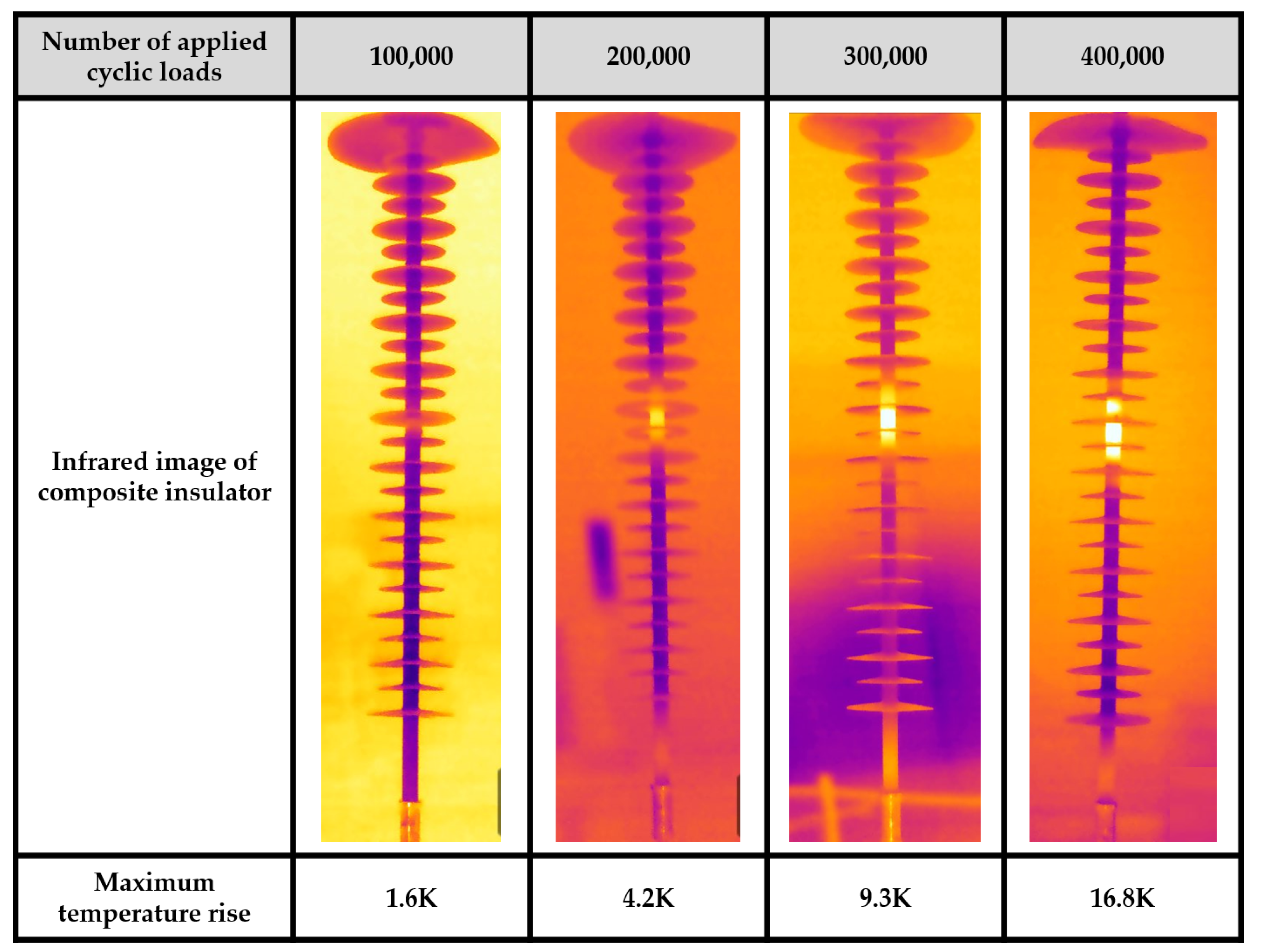
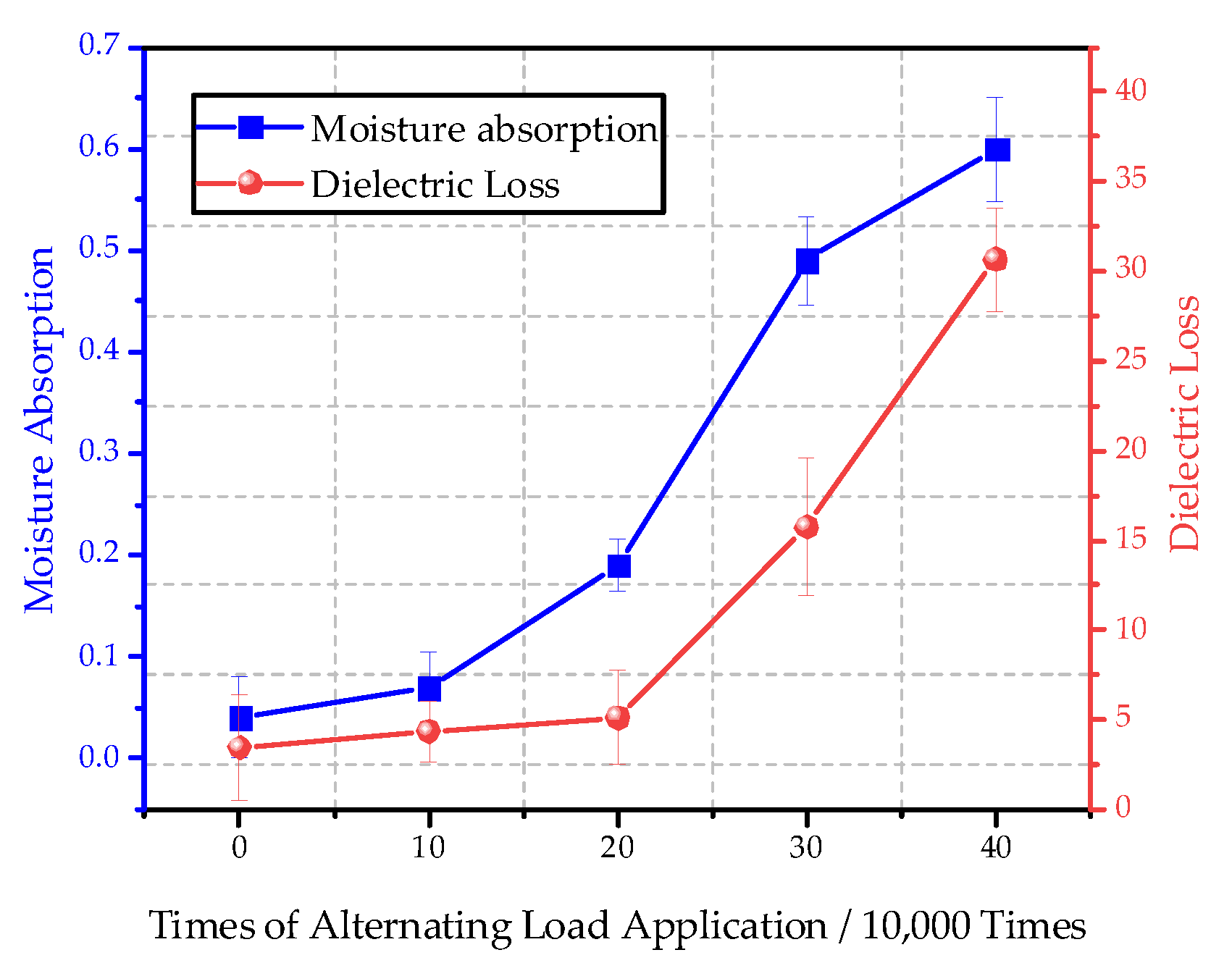

| Material Phase | Parameter | Value |
|---|---|---|
| Fiberglass | Density | 970 kg/m3 |
| Modulus of elasticity | E1 = 89,000 MPa, E2 = E3 = 8610 MPa | |
| Poisson’s ratio | σ12 = σ13 = 0.3, σ23 = 0.45 MPa | |
| Shear modulus | G12 = G13 = 4160 MPa, G23 = 3000 MPa | |
| Epoxy Matrix | Density | 1200 kg/m3 |
| Modulus of elasticity | 3450 MPa | |
| Poisson’s ratio | 0.35 | |
| Shear modulus | 0 | |
| Yield stress | 74.7 MPa | |
| Interface | Normal strength | 1000 MPa |
| Shear strength | 385 MPa |
| Parameter | Value |
|---|---|
| Rated mechanical tensile load | 70 kN |
| Insulation distance | 1000 mm |
| Min nominal creepage distance | 3150 mm |
| Number of umbrella skirts (large/small) | 25(9/16) |
| Core rod diameter | 18 mm |
| Sheath thickness | 4 mm |
| Maximum axial compression | 300 mm |
Disclaimer/Publisher’s Note: The statements, opinions and data contained in all publications are solely those of the individual author(s) and contributor(s) and not of MDPI and/or the editor(s). MDPI and/or the editor(s) disclaim responsibility for any injury to people or property resulting from any ideas, methods, instructions or products referred to in the content. |
© 2024 by the authors. Licensee MDPI, Basel, Switzerland. This article is an open access article distributed under the terms and conditions of the Creative Commons Attribution (CC BY) license (https://creativecommons.org/licenses/by/4.0/).
Share and Cite
Yi, X.; Ding, L.; Liu, H.; Zhang, J.; Liu, J.; Li, Z.; Zhang, Y.; Wang, P.; Geng, J. Study on the Mechanism Effect of Bending Loads on the Decay-like Degradation of Composite Insulator GFRP Core Rod. Energies 2024, 17, 423. https://doi.org/10.3390/en17020423
Yi X, Ding L, Liu H, Zhang J, Liu J, Li Z, Zhang Y, Wang P, Geng J. Study on the Mechanism Effect of Bending Loads on the Decay-like Degradation of Composite Insulator GFRP Core Rod. Energies. 2024; 17(2):423. https://doi.org/10.3390/en17020423
Chicago/Turabian StyleYi, Xiaoyu, Likun Ding, Hongliang Liu, Jiaxin Zhang, Jie Liu, Zhaohui Li, Yuming Zhang, Ping Wang, and Jianghai Geng. 2024. "Study on the Mechanism Effect of Bending Loads on the Decay-like Degradation of Composite Insulator GFRP Core Rod" Energies 17, no. 2: 423. https://doi.org/10.3390/en17020423
APA StyleYi, X., Ding, L., Liu, H., Zhang, J., Liu, J., Li, Z., Zhang, Y., Wang, P., & Geng, J. (2024). Study on the Mechanism Effect of Bending Loads on the Decay-like Degradation of Composite Insulator GFRP Core Rod. Energies, 17(2), 423. https://doi.org/10.3390/en17020423






